Don't Fall for It – Physical Therapy Exercises for Better Balance
Why Balance Problems Affect More People Than You Think
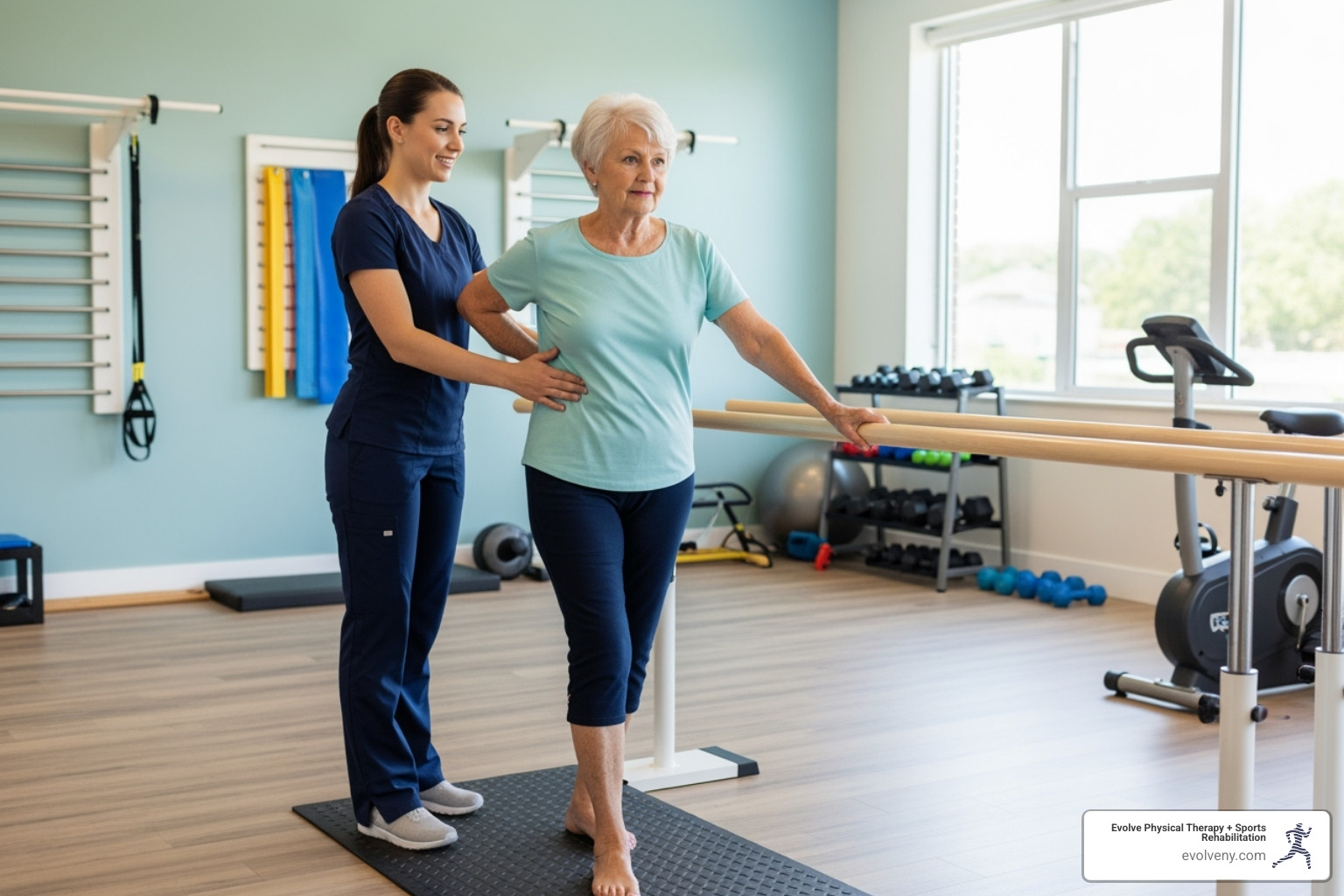
Physical therapy for balance is a specialized approach that helps millions regain stability, reduce fall risk, and restore confidence. It's proven to reduce fall risk in older adults by improving strength, coordination, and reaction time. Physical therapists use targeted exercises and vestibular rehabilitation therapy (VRT) to address root causes like inner ear problems, muscle weakness, and even medication side effects.
A physical therapist conducts a comprehensive balance assessment to create a personalized treatment plan. This involves hands-on therapy, strengthening exercises, and education on fall prevention.
Every second, a senior falls in the United States, but the good news is that falls are largely preventable. Balance is a skill you can improve at any age. Whether you're dealing with instability from an injury or just noticing you're not as steady as you used to be, physical therapy can help. It offers a proven path to rebuild the strength, coordination, and confidence needed to stay active.
I'm Lou Ezrick, founder of Evolve Physical Therapy. With nearly two decades of experience, I've seen that a personalized, hands-on approach to physical therapy for balance is the most effective way to help people overcome these challenges and address the whole person, not just the symptoms.
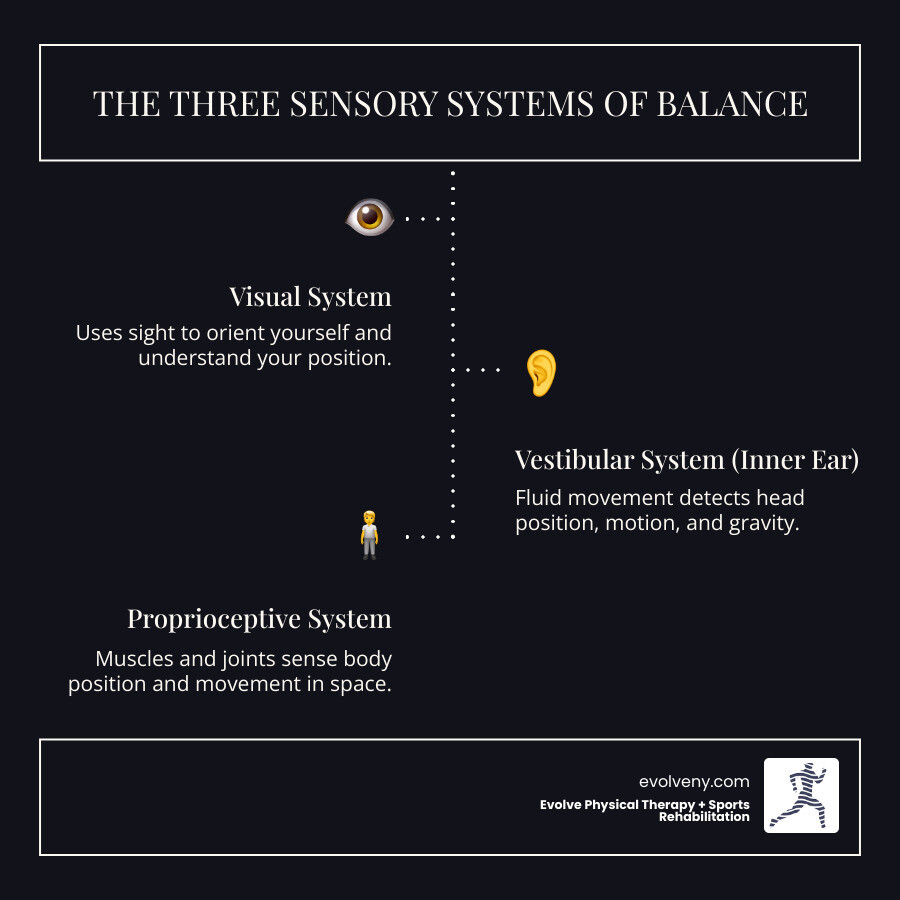
Why Am I Unsteady? Understanding the Root Causes of Balance Problems
Feeling a sudden wobble or a shift in the room when you stand up are common signs of a balance issue. Balance is your body's ability to stay upright and stable. It has two main components: static balance for when you're still (like standing in line) and dynamic balance for when you're moving (like walking or turning). When this system is disrupted, you might feel unsteady, dizzy, or experience vertigo—the sensation that the world is spinning. Staggering or swaying, especially when changing positions, are also common symptoms.
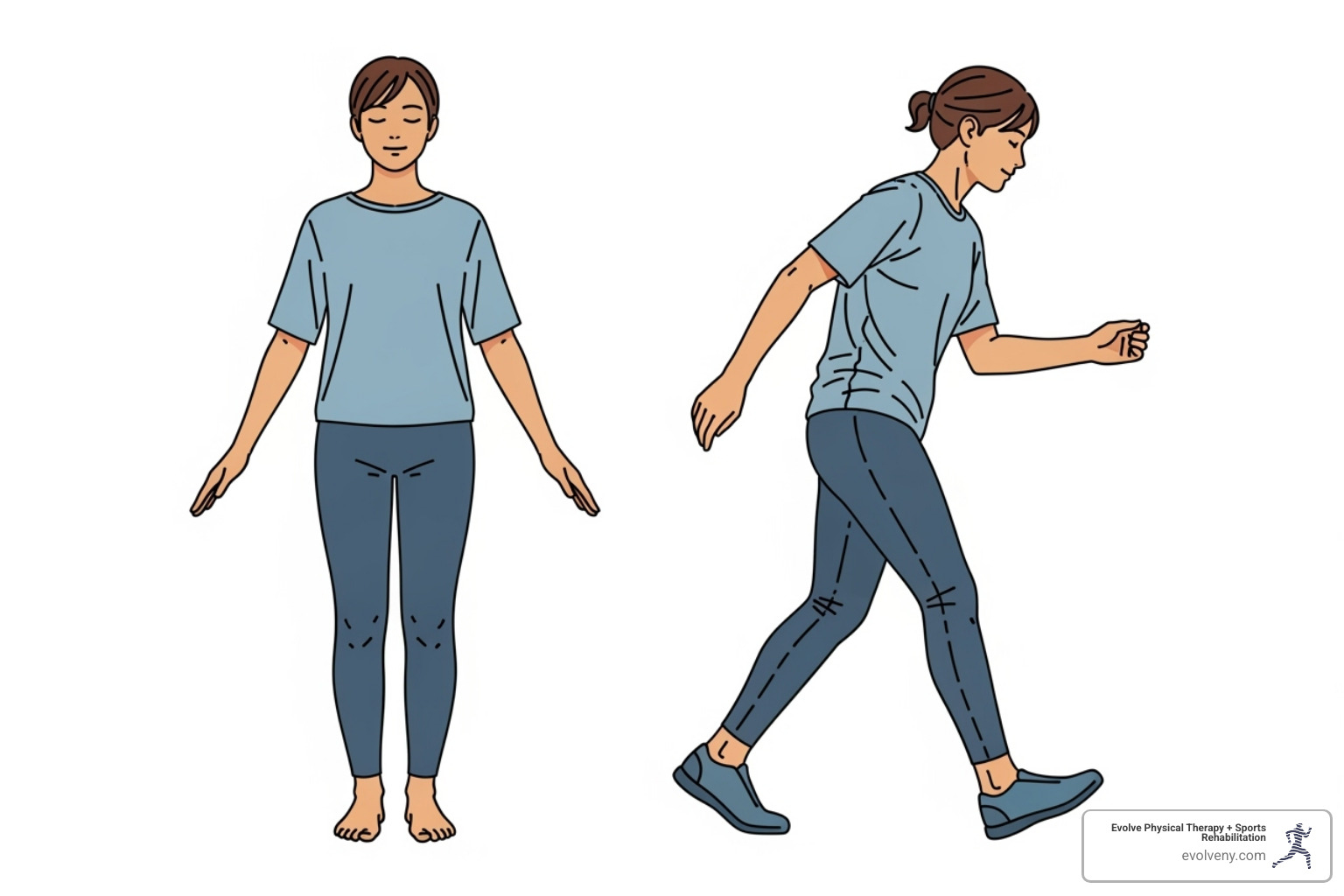
Common Causes of Imbalance
Balance problems often stem from a combination of factors. Age-related changes are significant, as muscles weaken, joints stiffen, and sensory systems become less sharp. Our team has extensive experience helping older adults maintain independence through targeted physical therapy for seniors.
Muscle weakness and joint stiffness are major contributors. A strong core and legs are essential for stability. Your inner ear's vestibular system also plays a key role, and conditions like vertigo, Meniere's disease, or ear infections can disrupt it. Neurological conditions like stroke or Parkinson's disease can interfere with the brain-body communication needed for balance. Finally, don't overlook medication side effects, as many common drugs can cause dizziness or drowsiness.
How a Physical Therapist Diagnoses Balance Issues
At Evolve Physical Therapy, we focus on finding the root cause. We start with a comprehensive health history to understand your symptoms and how they affect your life. Our movement screening involves observing how you walk, stand, and move. We use standardized balance tests, like the Timed Up and Go test, to get objective measurements of your stability.
By systematically testing your vision, vestibular system (inner ear), and proprioception (body awareness), we can identify which systems are struggling. This allows us to create a treatment plan designed for your unique situation, which is why physical therapy for balance is so effective. You can learn more about our personalized PT plans and how we tailor each treatment.
The Professional Approach: How Physical Therapy for Balance Restores Stability
Working with a movement expert for physical therapy for balance means you get a scientific approach, not a generic set of exercises. After our assessment identifies the root cause of your issues, we create a personalized treatment plan. Our goal is to dramatically reduce your fall risk and restore your confidence, which is crucial. Fear of falling can lead to a less active, more isolated life. We help people break that cycle.
For more specialized vestibular issues, we offer comprehensive vestibular physical therapy in Brooklyn to address inner ear-related balance problems.
Types of Specialized Balance Training
If inner ear problems are the cause, we use Vestibular Rehabilitation Therapy (VRT) to retrain your brain to better process signals from your inner ear, eyes, and body. This includes:
- Gaze stabilization exercises: To help you see clearly when your head is moving.
- Habituation exercises: To gradually reduce dizziness triggered by specific movements or busy environments.
- Repositioning maneuvers: For conditions like BPPV, these precise movements can provide immediate relief by repositioning inner ear crystals.
Strength, Coordination, and Reaction Training
Balance also requires physical strength and coordination. We focus on:
- Core strengthening: A strong core is the foundation for safe movement.
- Lower body exercises: Strong hips, thighs, and calves are your pillars of support.
- Proprioceptive training: This sharpens your body's internal awareness, or "sixth sense," often by using unstable surfaces or having you close your eyes. You can learn more about dynamic balance training and how we incorporate these challenging movements.
- Perturbation-Based Training (PBT): This advanced technique uses small, controlled pushes or shifts to improve your reaction time. Research shows this can reduce fall rates significantly and builds trust in your body's ability to recover from unexpected disturbances.
Your At-Home Balance Workout: 6 Essential Exercises
Consistent home practice is where the real magic of physical therapy for balance happens, building the muscle memory and confidence you need. Safety first: Always check with your healthcare provider before starting a new routine. Perform these exercises near a sturdy support like a kitchen counter or wall. Listen to your body and aim for practice at least twice a week. For additional guidance on creating your home routine, check out our comprehensive guide on balance exercises at home.
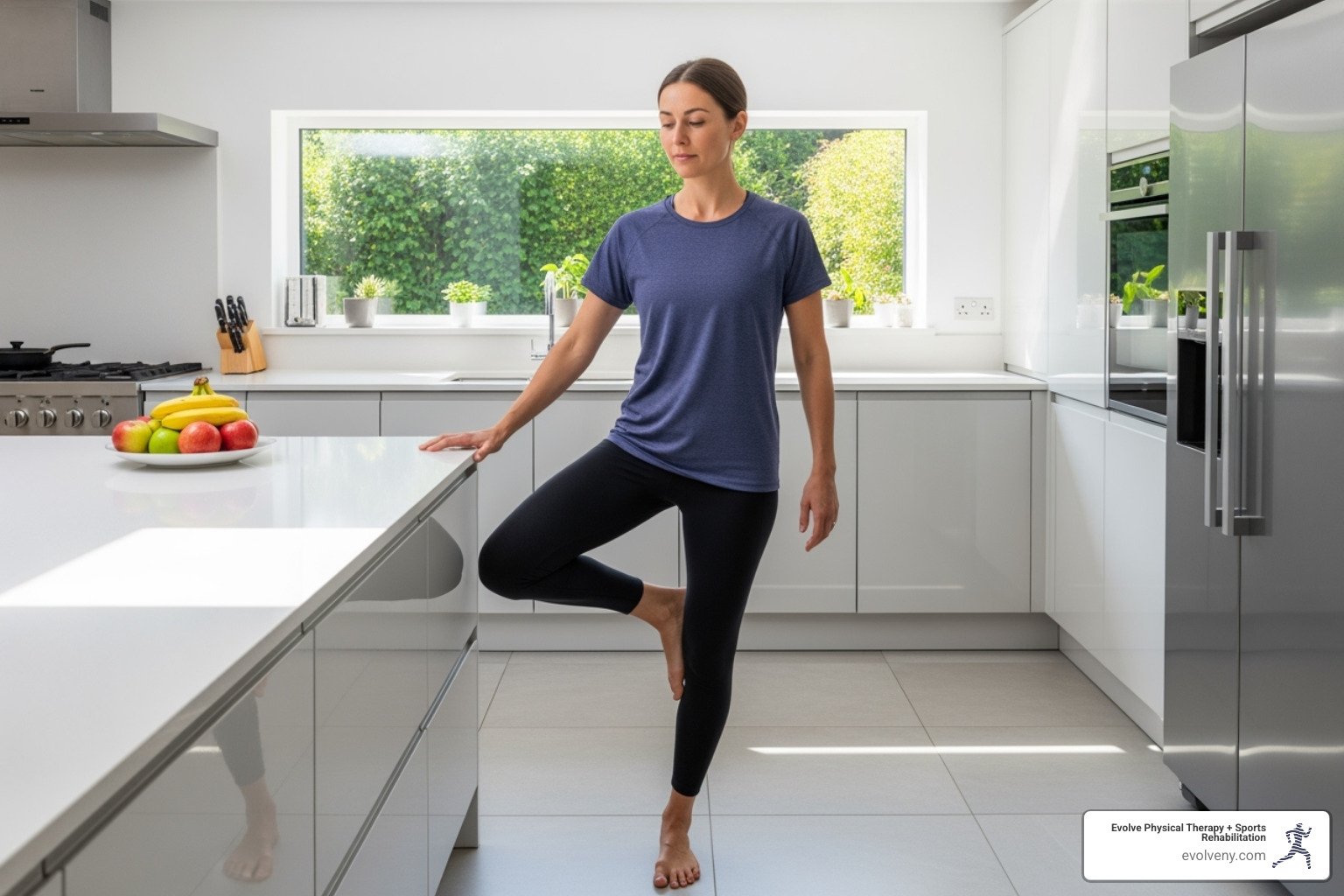
Foundational Physical Therapy for Balance Exercises
These exercises build static balance - your ability to stay steady when you're not moving.
- Sit-to-Stands: From a sturdy chair, stand up without using your hands, then slowly lower yourself back down. This builds essential leg strength for daily activities.
- Weight Shifts: Standing with feet hip-width apart, slowly shift your weight from one foot to the other. This improves your body's ability to make small, stabilizing adjustments.
- Single-Leg Stance: Holding onto support, lift one leg and hold for 5-10 seconds, working up to 30. This strengthens key stabilizing muscles in your ankles, knees, and hips.
Dynamic Physical Therapy for Balance Exercises
Now we move into dynamic balance - staying steady while you're moving.
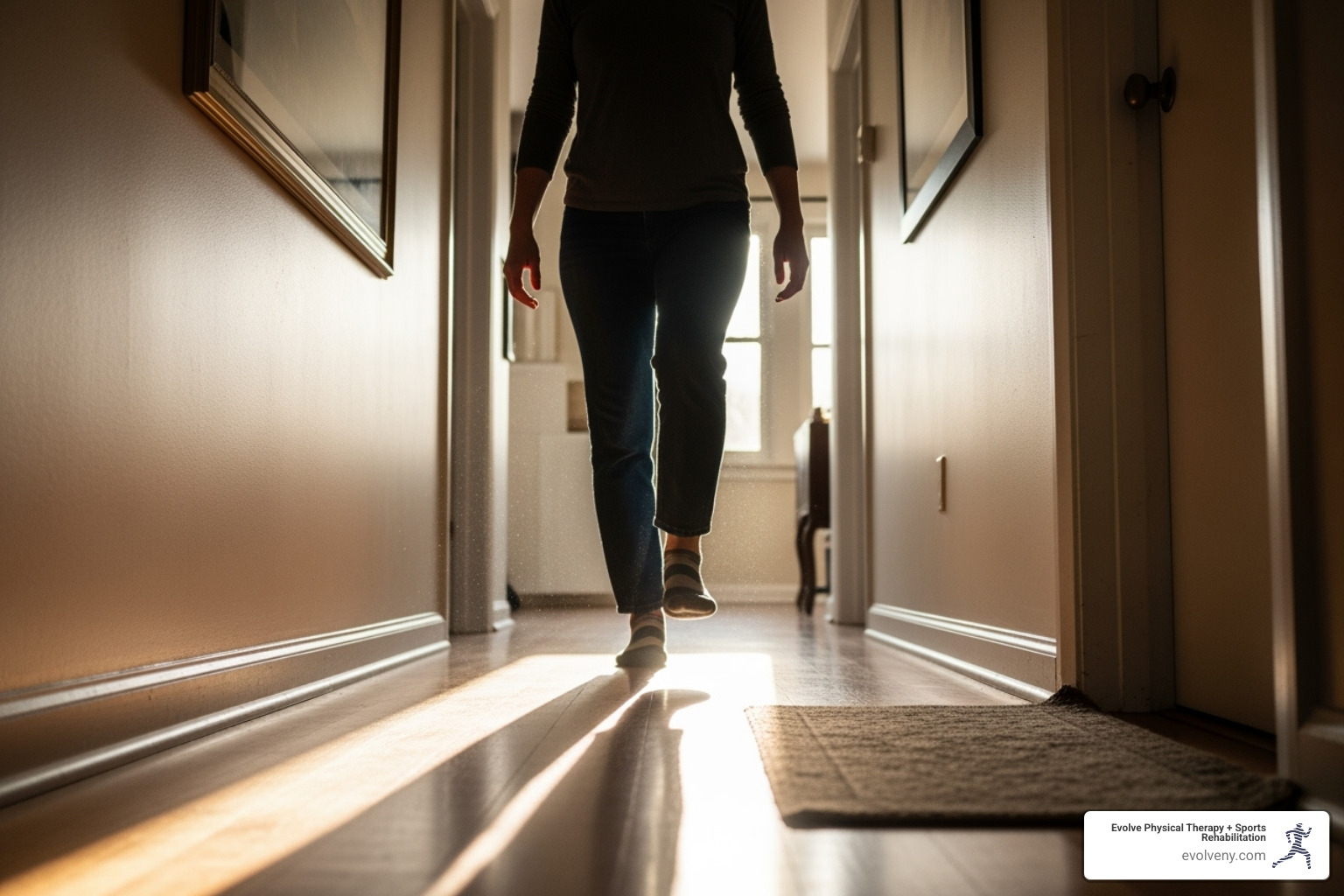
- Heel-to-Toe Walk: Walk in a straight line, placing the heel of one foot directly in front of the toes of the other. Look forward, not down, to improve your body's spatial awareness.
- Sidestepping: Step sideways for 10 steps, then return. This improves lateral stability, which is crucial for preventing falls.
- Step-Ups: Use a low, sturdy step or the bottom stair. Step up with one leg, then the other, and step back down. This builds strength and coordination for stairs and curbs.
Consistent practice is key. Some days will be better than others, but with regular effort, you'll feel much steadier and more confident.
Making Stability a Habit: Progression and Lifestyle Tips
Once you're comfortable with the basic physical therapy for balance exercises, it's time to challenge yourself. Progressing exercises safely means gently pushing your boundaries. Try reducing your hand support, performing exercises with your eyes closed (always near a wall for safety), adding head turns, or balancing on unstable surfaces like a folded towel or pillow. These progressions force your balance systems to work harder and adapt. As your balance improves, so will your gait. Learn more info on balance and gait training to see how these systems connect.
Lifestyle Changes for Lasting Balance
Creating a balance-friendly lifestyle is key. Make simple home safety modifications like securing loose rugs and adding nightlights. Wear proper footwear with good support and grip. Schedule a medication review with your doctor to see if any prescriptions are causing dizziness. Finally, don't skip annual vision and hearing exams, as both senses are vital for balance.
Integrating Balance into Daily Life
You can sneak balance training into your daily routine. Try one-leg stands while brushing your teeth or tandem (heel-to-toe) walking in hallways. Whenever possible, take the stairs to build strength and coordination. You might also enjoy balance-focused group classes like Tai Chi, which is proven to improve postural stability.
The evidence supporting exercise for fall prevention is overwhelming. Research shows that physical activity, especially programs that include balance and strength training, can significantly reduce falls in older adults. Every small improvement you make builds toward a more stable and confident future.
Frequently Asked Questions About Balance Therapy
Here are answers to some common questions about physical therapy for balance.
How long does it take to improve my balance with physical therapy?
The timeline varies by individual and depends on the cause of your issues, your overall health, and your consistency with exercises. Many patients notice improvements within a few weeks, with more significant gains over weeks to months. For some vestibular conditions like BPPV, relief can come after just one session. Consistency is key to achieving the best results, and we'll help you set realistic goals.
Can physical therapy help with dizziness and vertigo?
Yes, absolutely. Vestibular Rehabilitation Therapy (VRT) is specifically designed to treat dizziness and vertigo, especially when caused by inner ear problems. We use targeted exercises and specific maneuvers to retrain your brain and sensory systems, often leading to a significant reduction in symptoms.
When should I see a physical therapist for balance problems?
You should consider seeing a physical therapist if you:
- Have had a fall, even a minor one.
- Feel unsteady on a regular basis.
- Experience dizziness or vertigo.
- Have difficulty with daily activities like walking or climbing stairs.
Proactive fall prevention is also a smart reason to see a PT, especially if you are over 65 or have risk factors. In New York, you can contact us directly for an evaluation without a doctor's referral.
Take the First Step Towards a More Stable Future
You now know that falls are preventable and that balance is a skill you can improve at any age. We've seen how factors from muscle weakness to inner ear problems can affect stability, and how physical therapy for balance offers targeted, evidence-based solutions.
At Evolve Physical Therapy + Sports Rehabilitation, our hands-on approach is designed to find and treat the root cause of your unsteadiness. We create personalized plans for everyone, from active Brooklyn professionals to those seeking proactive fall prevention. Our expertise in vestibular rehabilitation and strength training can help you regain stability and confidence.
You don't have to accept unsteadiness or live with the fear of falling. With professional guidance and consistent practice, you can build a more stable, confident future.
Schedule a personalized physical therapy evaluation today and take the first step. Let us help you create a plan to get back on solid ground. Your journey to better balance starts now.

